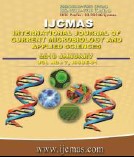


 National Academy of Agricultural Sciences (NAAS)
National Academy of Agricultural Sciences (NAAS)

|
PRINT ISSN : 2319-7692
Online ISSN : 2319-7706 Issues : 12 per year Publisher : Excellent Publishers Email : editorijcmas@gmail.com / submit@ijcmas.com Editor-in-chief: Dr.M.Prakash Index Copernicus ICV 2018: 95.39 NAAS RATING 2020: 5.38 |
Generation mean analysis was carried out with 5 generations (P1, P2, F1, F2, and F3) crossing 5 aromatic and 3 non-aromatic genotypes of rice for prime kernel quality characteristics and grain yield per plant. Besides main genetic effects (d and h), interaction effects (i and l) were also highly significant for quality traits, indicating the importance of epistasis exploitation in breeding for quality rices. Four crosses registered kernel length of more than 6.0 mm, two crosses (Improved Pusa Basmati x Basmati 370 and Sumathi x Improved Pusa Basmati) among these were identified as top ranking ones, as the genetic effects (d and i) were significant in desirable side. For kernel shape (L/B ratio), the genetic effects (d and i) were negative direction, epistasis was of duplicate nature, which indicated adoption of special breeding method for improvement. For overall quality improvement, Sumathi x Improved Pusa Basmati and Improved Pusa Basmati x Basmati 370 and for quality and yield NLR 145 x Sumathi, Akshyadhan x Pusa 1121 combinations were recommended for advancement. The main genetic and epistatic effects changed with change of cross and differed depending on quality trait in rice.
 |
 |
 |
 |
 |